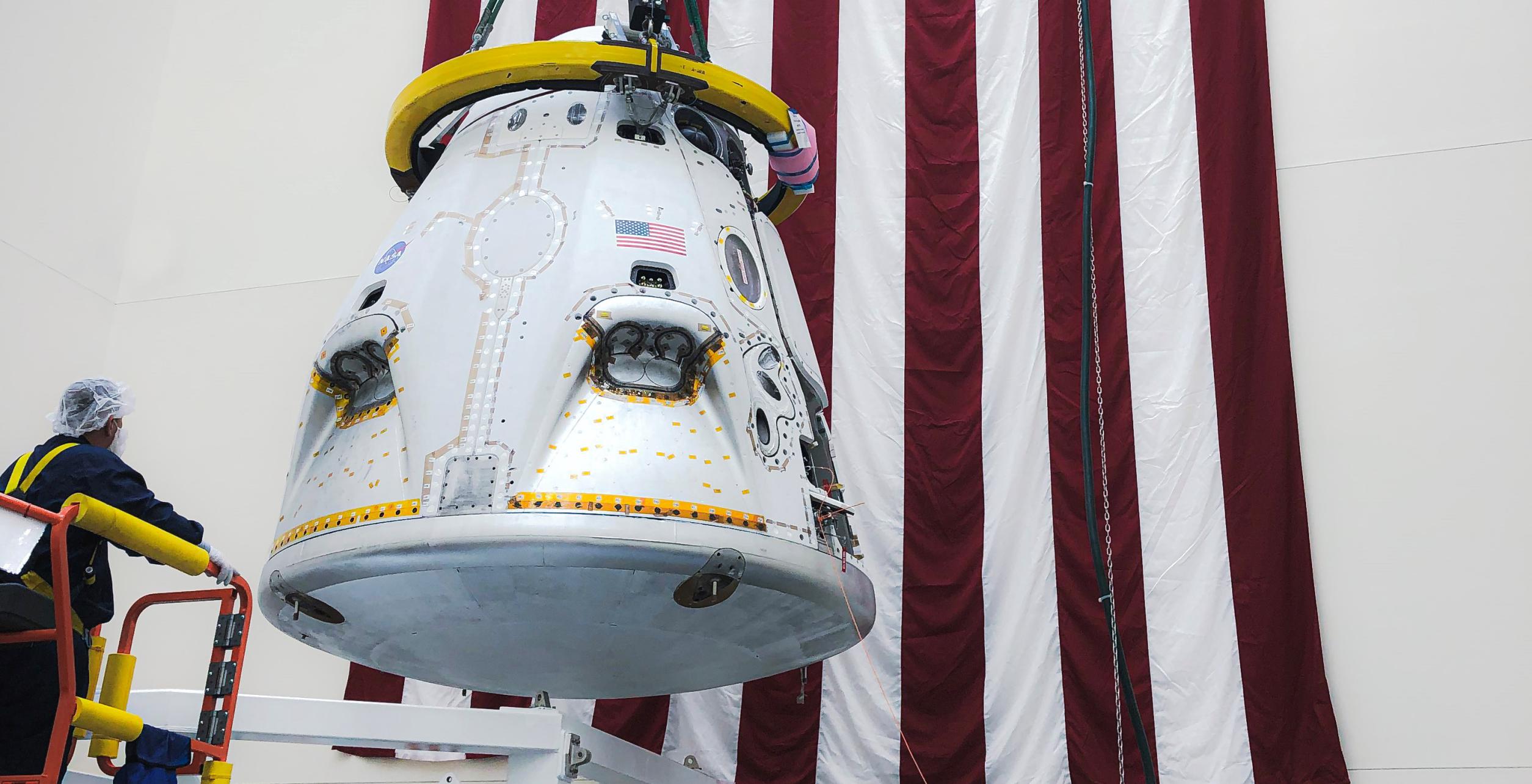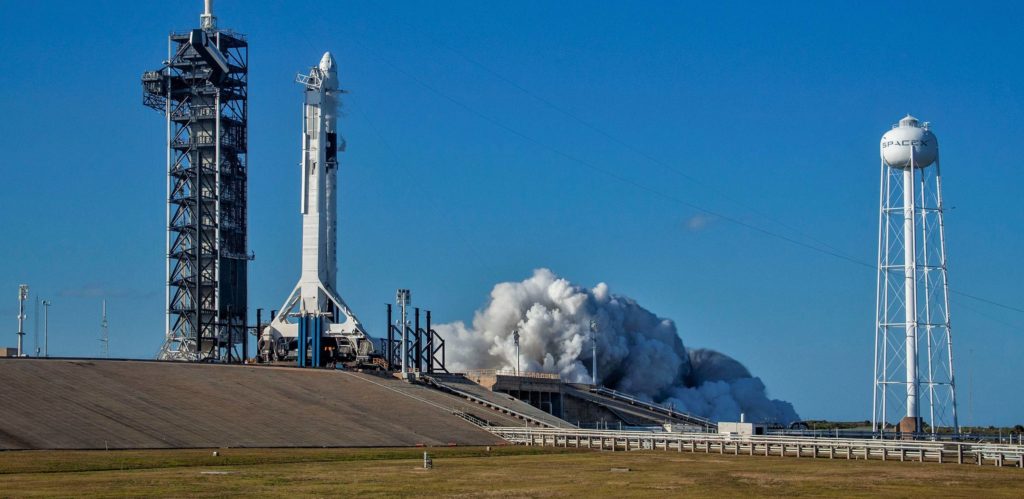

News
SpaceX Crew Dragon spacecraft shown off in photo ahead of next launch
NASA has published a new SpaceX photo of the next Crew Dragon spacecraft scheduled for launch and confirmed that the mission is now scheduled to lift off on a Falcon 9 rocket no earlier than (NET) January 18th.
Known as an In-Flight Abort (IFA) test, the exceptionally challenging mission will represent a major milestone for Crew Dragon regardless of the results. Meant to simulate an abort at the (near) worst possible time during launch, Crew Dragon will ignite its SuperDraco abort thrusters around 60-90 seconds after liftoff, subjecting the spacecraft to even more extreme stresses around the same time both it and Falcon 9 are passing through Max Q – “the moment of peak mechanical stress”. If the test is unsuccessful, SpaceX Demo-2 – Crew Dragon’s first NASA astronaut launch – would almost certainly be delayed several months.
If successful, however, it could pave the way for Crew Dragon’s first astronaut perhaps just a month or two later, although Q2 2020 is much more likely. Simultaneously, while difficult to rationally explain, Boeing appears confident that its Starliner spacecraft – having lost control and failed to reach the International Space Station (ISS) barely more than a week ago and suffered a parachute deployment failure on a pad abort test one month prior – is still on track for its first astronaut launch (“Crewed Flight Test”, CFT) just a handful of months from now. In line with the special treatment NASA seems fated to bestow upon Boeing, it appears that Crew Dragon and Starliner’s unofficial race to become the first commercial spacecraft to launch astronauts is as close as it’s ever been.
Regardless, January 18th represents a delay of one week since SpaceX and NASA’s last launch date announcement – NET January 11th, 2020 as of December 18th, 2019. January 11th was itself a week delay from January 4th, the first specific In-Flight Abort launch target released on December 6th, 2019. The date of Crew Dragon’s IFA test has thus technically slipped 14 days in the last 31 days, although it has also technically slipped 7 days in the last 19.
In other words, as previously discussed on Teslarati, those two weeks of delays mean that Falcon 9 and Crew Dragon will almost certainly launch sometime in January 2020 – a significant improvement in schedule assurance compared to Crew Dragon’s Demo-1 launch debut, which suffered some three months of delays despite its hardware being ready for flight throughout.


With any luck, thrice-flown Falcon 9 booster B1046 – all but guaranteed to be destroyed by Dragon’s abort test – could launch new Crew Dragon capsule C205 and an expendable trunk section perhaps just a single week after performing a routine static fire and wet dress rehearsal at Pad 39A. That would represent an almost sixfold improvement relative to the timing of the spacecraft’s first Falcon 9 launch, which took some six weeks to go from static fire to liftoff.
NASA says that the delay from January 11th to January 18th “allows additional time for spacecraft processing”, although the reality is almost certainly a pretty even split between SpaceX processing and NASA’s plodding review process (i.e. paperwork). Regardless, now standing just 11 days from the latest launch date, Crew Dragon’s second Falcon 9 launch is rapidly converging on a liftoff sometime in the last two weeks of January 2020.
Check out Teslarati’s Marketplace! We offer Tesla accessories, including for the Tesla Cybertruck and Tesla Model 3.

News
Tesla (TSLA) receives “Buy” rating and $551 PT from Canaccord Genuity
He also maintained a “Buy” rating for TSLA stock over the company’s improving long-term outlook, which is driven by autonomy and robotics.

Canaccord Genuity analyst George Gianarikas raised his Tesla (NASDAQ:TSLA) price target from $482 to $551. He also maintained a “Buy” rating for TSLA stock over the company’s improving long-term outlook, which is driven by autonomy and robotics.
The analyst’s updated note
Gianarikas lowered his 4Q25 delivery estimates but pointed to several positive factors in the Tesla story. He noted that EV adoption in emerging markets is gaining pace, and progress in FSD and the Robotaxi rollout in 2026 represent major upside drivers. Further progress in the Optimus program next year could also add more momentum for the electric vehicle maker.
“Overall, yes, 4Q25 delivery expectations are being revised lower. However, the reset in the US EV market is laying the groundwork for a more durable and attractive long-term demand environment.
“At the same time, EV penetration in emerging markets is accelerating, reinforcing Tesla’s potential multi‑year growth runway beyond the US. Global progress in FSD and the anticipated rollout of a larger robotaxi fleet in 2026 are increasingly important components of the Tesla equity story and could provide sentiment tailwinds,” the analyst wrote.
Tesla’s busy 2026
The upcoming year would be a busy one for Tesla, considering the company’s plans and targets. The autonomous two-seat Cybercab has been confirmed to start production sometime in Q2 2026, as per Elon Musk during the 2025 Annual Shareholder Meeting.
Apart from this, Tesla is also expected to unveil the next-generation Roadster on April 1, 2026. Tesla is also expected to start high-volume production of the Tesla Semi in Nevada next year.
Apart from vehicle launches, Tesla has expressed its intentions to significantly ramp the rollout of FSD to several regions worldwide, such as Europe. Plans are also underway to launch more Robotaxi networks in several more key areas across the United States.
News
Waymo sues Santa Monica over order to halt overnight charging sessions
In its complaint, Waymo argued that its self-driving cars’ operations do not constitute a public nuisance, and compliance with the city’s order would cause the company irreparable harm.

Waymo has filed a lawsuit against the City of Santa Monica in Los Angeles County Superior Court, seeking to block an order that requires the company to cease overnight charging at two facilities.
In its complaint, Waymo argued that its self-driving cars’ operations do not constitute a public nuisance, and compliance with the city’s order would cause the company irreparable harm.
Nuisance claims
As noted in a report from the Los Angeles Times, Waymo’s two charging sites at Euclid Street and Broadway have operated for about a year, supporting the company’s growing fleet with round-the-clock activity. Unfortunately, this has also resulted in residents in the area reportedly being unable to sleep due to incessant beeping from self-driving taxis that are moving in and out of the charging stations around the clock.
Frustrated residents have protested against the Waymos by blocking the vehicles’ paths, placing cones, and “stacking” cars to create backups. This has also resulted in multiple calls to the police.
Last month, the city issued an order to Waymo and its charging partner, Voltera, to cease overnight operations at the charging locations, stating that the self-driving vehicles’ activities at night were a public nuisance. A December 15 meeting yielded no agreement on mitigations like software rerouting. Waymo proposed changes, but the city reportedly insisted that nothing would satisfy the irate residents.
“We are disappointed that the City has chosen an adversarial path over a collaborative one. The City’s position has been to insist that no actions taken or proposed by Waymo would satisfy the complaining neighbors and therefore must be deemed insufficient,” a Waymo spokesperson stated.
Waymo pushes back
In its legal complaint, Waymo stated that its “activities at the Broadway Facilities do not constitute a public nuisance.” The company also noted that it “faces imminent and irreparable harm to its operations, employees, and customers” from the city’s order. The suit also stated that the city was fully aware that the Voltera charging sites would be operating around the clock to support Waymo’s self-driving taxis.
The company highlighted over one million trips in Santa Monica since launch, with more than 50,000 rides starting or ending there in November alone. Waymo also criticized the city for adopting a contentious strategy against businesses.
“The City of Santa Monica’s recent actions are inconsistent with its stated goal of attracting investment. At a time when the City faces a serious fiscal crisis, officials are choosing to obstruct properly permitted investment rather than fostering a ‘ready for business’ environment,” Waymo stated.
News
Tesla FSD v14.2.2 is getting rave reviews from drivers
So far, early testers have reported buttery-smooth drives with confident performance, even at night or on twisty roads.

Tesla Full Self-Driving (Supervised) v14.2.2 is receiving positive reviews from owners, with several drivers praising the build’s lack of hesitation during lane changes and its smoother decision-making, among others.
The update, which started rolling out on Monday, also adds features like dynamic arrival pin adjustment. So far, early testers have reported buttery-smooth drives with confident performance, even at night or on twisty roads.
Owners highlight major improvements
Longtime Tesla owner and FSD user @BLKMDL3 shared a detailed 10-hour impression of FSD v14.2.2, noting that the system exhibited “zero lane change hesitation” and “extremely refined” lane choices. He praised Mad Max mode’s performance, stellar parking in locations including ticket dispensers, and impressive canyon runs even in dark conditions.
Fellow FSD user Dan Burkland reported an hour of FSD v14.2.2’s nighttime driving with “zero hesitations” and “buttery smooth” confidence reminiscent of Robotaxi rides in areas such as Austin, Texas. Veteran FSD user Whole Mars Catalog also demonstrated voice navigation via Grok, while Tesla owner Devin Olsen completed a nearly two-hour drive with FSD v14.2.2 in heavy traffic and rain with strong performance.
Closer to unsupervised
FSD has been receiving rave reviews, even from Tesla’s competitors. Xpeng CEO He Xiaopeng, for one, offered fresh praise for FSD v14.2 after visiting Silicon Valley. Following extended test drives of Tesla vehicles running the latest FSD software, He stated that the system has made major strides, reinforcing his view that Tesla’s approach to autonomy is indeed the proper path towards autonomy.
According to He, Tesla’s FSD has evolved from a smooth Level 2 advanced driver assistance system into what he described as a “near-Level 4” experience in terms of capabilities. While acknowledging that areas of improvement are still present, the Xpeng CEO stated that FSD’s current iteration significantly surpasses last year’s capabilities. He also reiterated his belief that Tesla’s strategy of using the same autonomous software and hardware architecture across private vehicles and robotaxis is the right long-term approach, as it would allow users to bypass intermediate autonomy stages and move closer to Level 4 functionality.








